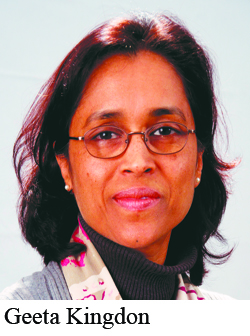 In a dramatic about-turn on the issue of testing learning outcomes of children in all primary and upper primary classes, the historic Right to Free & Compulsory Education (aka RTE) Act, 2009 has abolished examinations. S.16 of the RTE Act prohibits detention or expulsion of students in elementary school (classes I-VIII) for any reason, and s.30(1) explicitly states that “no child shall be required to pass any board examination till the completion of elementary education”.
In a dramatic about-turn on the issue of testing learning outcomes of children in all primary and upper primary classes, the historic Right to Free & Compulsory Education (aka RTE) Act, 2009 has abolished examinations. S.16 of the RTE Act prohibits detention or expulsion of students in elementary school (classes I-VIII) for any reason, and s.30(1) explicitly states that “no child shall be required to pass any board examination till the completion of elementary education”.
It is widely believed that the prime mover behind the abolition of testing and detention was Vinod Raina, one of the architects of the RTE Act, and visiting senior fellow at the Delhi-based Centre for the Study of Developing Societies and a member of the Central Advisory Board for Education. In a comment column titled ‘Tests are torture’ (India Today, January 25), Raina confirmed this speculation. Criticising the high-profile launch of the Annual Status of Education Report 2012 in mid-January, he advanced two arguments against testing — that tests findings are being publicised, and that teachers oppose testing of children.
Raina’s column attracted stinging rejoinders from eminent educationists. Writing in Indian Express (March 6) Lant Pritchett, professor at the Kennedy School of Govern-ment, Harvard University, opined that the guardians of Indian education are “passio-nately committed to ignorance: they strongly believe no one must know what Indian children know”. Responding in India Today (March 11) Abhijit Banerji and Esther Duflo of MIT expressed astonishment at the reaction to India’s poor performance in international tests. “The child has fever; break the thermometer. The thermometer stresses the child out and must be what gives him fever,’’ wrote the authors of the best-seller Poor Economics (2011).
What are the rights and wrongs of testing children? There is little diagnostic testing in much of the government schooling sector, barring the 10,000 CBSE-affiliated schools, where formative assessment in the form of continuous and comprehensive evaluation (CCE) has recently been introduced.
Despite the RTE Act’s emphasis on school inputs (infrastructure, class-size and teacher qualifications) and neglect of learning outcomes, the plain reality is that children’s learning levels are the most commonly sought signal of school quality. Countries hawkishly compare student learning attainments in international tests such as PISA and TIMSS, and institute major education reforms based on results data. Employers recruit based on applicants’ learning levels; colleges base admissions on students’ learning achieve-ments; and parents value children’s report cards. Most industrialised countries do test their children’s learning attainments at key stages within national achievement-testing systems, and also by participating in international tests such as TIMSS, PIRLS and PISA, in which they nervously monitor their ranking.
Recently, China and India took tentative steps in this direction by participating in the Programme for International Student Assessment (PISA) which tests the maths, science and English attainments of 15-year-olds. However, following India’s poor performance in PISA 2011 (73rd position out of 74 countries), the Union HRD ministry has decreed India will not take part in PISA for the next ten years. The ministry’s decision to boycott PISA tests is akin to burying one’s head in the sand, ostrich fashion. The education establishment and its apologists are in denial. When the body is sick, it needs medicine, even if the medicine is bitter.
Measurement of learning outcomes serves several purposes. Perhaps the first purpose (and effect) of testing children in a country is to draw public attention to prevailing levels of cognitive skills, which can raise awareness and provoke education reform. India’s ASER reports (2005-2013) which provide data on the numeracy and literacy of over 700,000 rural primary children each year — drew public attention to the seriously low learning outcomes of children in primary (classes I-VII) education, and this has generated healthy policy debate and public appetite for reform.
Generally speaking, teachers everywhere oppose testing. Testing is laborious business. Test papers need to be set, exams conducted, answer scripts marked, report cards made and results may have to be explained to parents. The burden of all this falls on the teacher. If children don’t do well, teachers are called to account. Banerji and Duflo argue that Raina and the educational establishment’s “primary constituency are teachers, rather than students…That is why he and so many other established experts have always been uncomfortable with ASER and public exams in general, why the RTE comes with no right to find out whether education is in fact being delivered”.
If the Union government wishes to accord greater emphasis to quality of education, it should start generating evidence by measuring children’s learning levels — for diagnostic and accountability-raising, if not punitive purposes. The Planning Commission’s 12th Plan chapter on education agrees: it strongly emphasises the importance of testing children’s learning outcomes. Education policy needs to be based on evidence, not on ideological orthodoxy which hasn’t served the children of India well.
(Dr. Geeta Gandhi Kingdon is professor of education at the University of London)